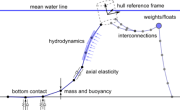Software
Smoothed Particle Hydrodynamics (SPH) describes a fluid by replacing its continuum properties with locally smoothed quantities at discrete Lagrangian locations named particles. Each particle is a nodal point where physical quantities are computed as an interpolation of the values of the neighbouring particles solving the Navier-Stokes equations. Hence, SPH is an ideal technique to simulate free-surface flows and presents several advantages compared with meshbased methods to simulate violent wave-structure interaction: i) there is no special treatment to detect the free surface so large deformation can be efficiently treated since there is no mesh distortion, ii) moving complex boundaries and interfaces are easily handled, iii) multiphase flows are simulated without the need of special variables to detect the phases in the space since each individual particle holds material properties of its phase and iv) natural incorporation of coefficient discontinuities and singular forces into the numerical scheme.
The DualSPHysics code is developed by researchers from Universidade de Vigo (Spain) and other institutions from Portugal, United Kingdom, Belgium and Italy. DualSPHysics has been developed to use SPH for real engineering problems with software that can be run on either CPUs or GPUs (graphics cards with powerful parallel computing). GPUs offer now a higher computing power than CPUs and they are an affordable option to accelerate SPH with a low economic cost. Thereby, the simulations can be performed using a GPU card installed on a personal computer. DualSPHysics is open source and can be freely downloaded from www.dual.sphysics.org. DualSPHysics code was applied to coastal engineering problems, e.g. to study the run-up on a real armour block coastal breakwater and to estimate sea wave impact on coastal structures where the numerical results have been validated with the experimental data for typical cases from the Belgian coast. In addition, for the purpose of providing a general model, relevant modes of interaction are not always evident, in which case high spatial and temporal resolutions must be attainable. Furthermore, some simulations may require remarkably large domains. This stresses the need for high performance codes and implementations and it means that DualSPHysics is a perfect candidate since it is the most efficient SPH code worldwide. The DualSPHysics code is here applied to simulate the interaction between sea waves and OWC.
The MoorDyn library is an open-source dynamic mooring line model. MoorDyn is a lumped-mass mooring line model designed for easy coupling with other software (i.e. floating platform models). It supports arbitrary line interconnections, clump weights and floats, and different line properties. The model accounts for internal axial stiffness and damping forces, weight and buoyancy forces, hydrodynamic forces from Morison’s equation, and vertical spring-damper forces from contact with the seabed. It has been developed by Matt Hall (University of Prince Edward Island, Canada). More information and downloads can be found at www.matt-hall.ca/software/moordyn.
The Project Chrono library is developed as general-purpose simulator for three dimensional multi-body problems with support for very large systems. The library is successfully built under the DualSPHysics implementation, providing an integrated interface to define and run arbitrarily defined fluid-structure-structure coupled systems. The Project Chrono implementation allows for the straightforward definition of a large number of constraints such as joints and sliders, with arbitrary degrees of freedom. The main contribution however is the efficient treatment of such kinematic restrictions with user defined dynamic properties such as friction and restitution coefficients, restitution forces from spring and damper systems and user-imposed forces and trajectories. More information can be found at www.projectchrono.org.


